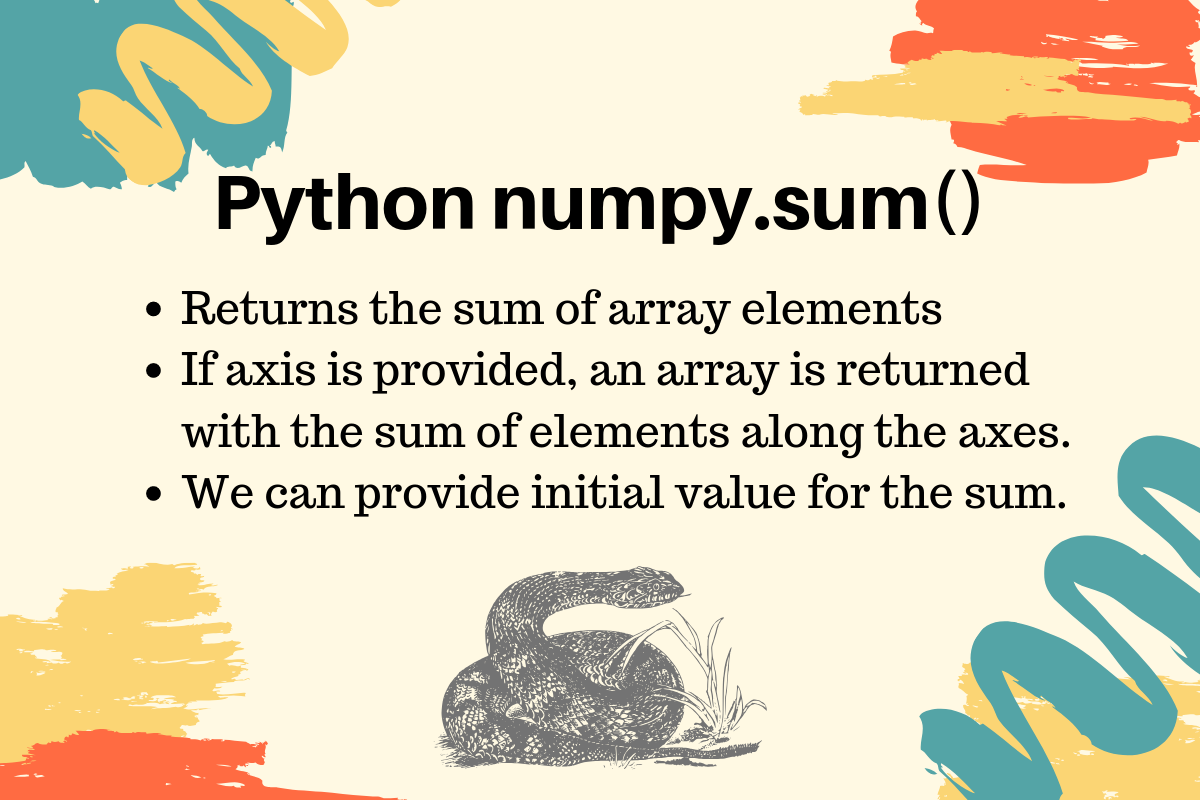- Log in to:
- Community
- DigitalOcean
- Sign up for:
- Community
- DigitalOcean

Python numpy sum() function is used to get the sum of array elements over a given axis.
Python numpy sum() function syntax
Python NumPy sum() method syntax is:
sum(array, axis, dtype, out, keepdims, initial)
- The array elements are used to calculate the sum.
- If the axis is not provided, the sum of all the elements is returned. If the axis is a tuple of ints, the sum of all the elements in the given axes is returned.
- We can specify dtype to specify the returned output data type.
- The out variable is used to specify the array to place the result. It’s an optional parameter.
- The keepdims is a boolean parameter. If this is set to True, the axes which are reduced are left in the result as dimensions with size one.
- The initial parameter specifies the starting value for the sum.
Python numpy sum() Examples
Let’s look at some of the examples of numpy sum() function.
1. Sum of All the Elements in the Array
If we pass only the array in the sum() function, it’s flattened and the sum of all the elements is returned.
import numpy as np
array1 = np.array(
[[1, 2],
[3, 4],
[5, 6]])
total = np.sum(array1)
print(f'Sum of all the elements is {total}')
Output: Sum of all the elements is 21
2. Sum of Array Elements Along the Axis
If we specify the axis value, the sum of elements along that axis is returned. If the array shape is (X, Y) then the sum along 0-axis will be of shape (1, Y). The sum along 1-axis will be of shape (1, X).
import numpy as np
array1 = np.array(
[[1, 2],
[3, 4],
[5, 6]])
total_0_axis = np.sum(array1, axis=0)
print(f'Sum of elements at 0-axis is {total_0_axis}')
total_1_axis = np.sum(array1, axis=1)
print(f'Sum of elements at 1-axis is {total_1_axis}')
Output:
Sum of elements at 0-axis is [ 9 12]
Sum of elements at 1-axis is [ 3 7 11]
3. Specifying Output Data Type of Sum
import numpy as np
array1 = np.array(
[[1, 2],
[3, 4]])
total_1_axis = np.sum(array1, axis=1, dtype=float)
print(f'Sum of elements at 1-axis is {total_1_axis}')
Output: Sum of elements at 1-axis is [3. 7.]
4. Initial Value for the Sum
import numpy as np
array1 = np.array(
[[1, 2],
[3, 4]])
total_1_axis = np.sum(array1, axis=1, initial=10)
print(f'Sum of elements at 1-axis is {total_1_axis}')
Output: Sum of elements at 1-axis is [13 17] Reference: API Doc
Thanks for learning with the DigitalOcean Community. Check out our offerings for compute, storage, networking, and managed databases.
About the author
Java and Python Developer for 20+ years, Open Source Enthusiast, Founder of https://www.askpython.com/, https://www.linuxfordevices.com/, and JournalDev.com (acquired by DigitalOcean). Passionate about writing technical articles and sharing knowledge with others. Love Java, Python, Unix and related technologies. Follow my X @PankajWebDev
Still looking for an answer?
Dear Pankaj, I only want to sum some of the values not all. what should I do in that case? Imagine that It is an array including 0 and 1s and I would like to sum 1s before each zero not to sum all the 1s. I appreciate if you could help me.
- Mona
- Table of contents
- Python numpy sum() function syntax
- Python numpy sum() Examples
Deploy on DigitalOcean
Click below to sign up for DigitalOcean's virtual machines, Databases, and AIML products.
Become a contributor for community
Get paid to write technical tutorials and select a tech-focused charity to receive a matching donation.
DigitalOcean Documentation
Full documentation for every DigitalOcean product.
Resources for startups and SMBs
The Wave has everything you need to know about building a business, from raising funding to marketing your product.
Get our newsletter
Stay up to date by signing up for DigitalOcean’s Infrastructure as a Newsletter.
New accounts only. By submitting your email you agree to our Privacy Policy
The developer cloud
Scale up as you grow — whether you're running one virtual machine or ten thousand.
Get started for free
Sign up and get $200 in credit for your first 60 days with DigitalOcean.*
*This promotional offer applies to new accounts only.
